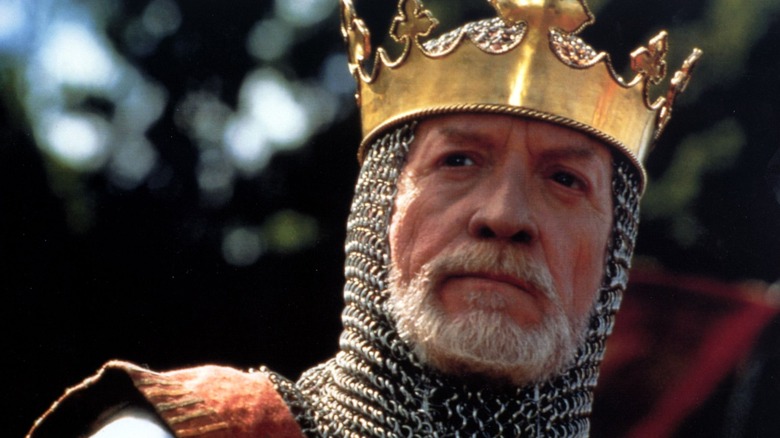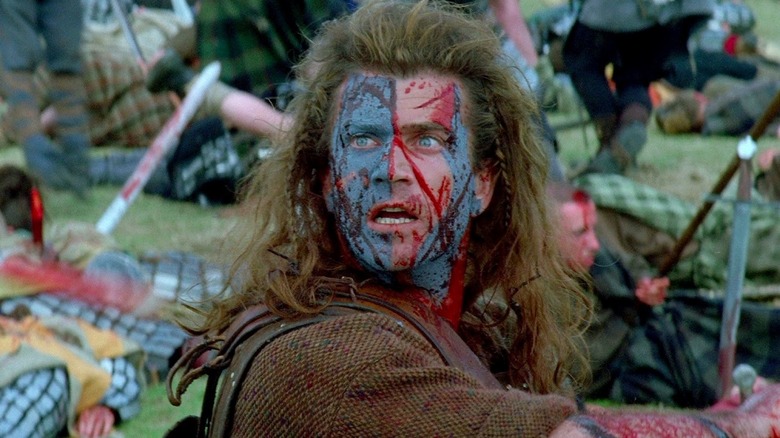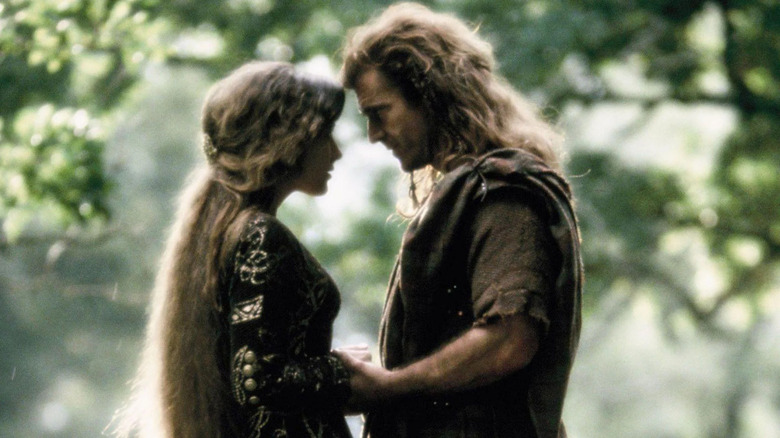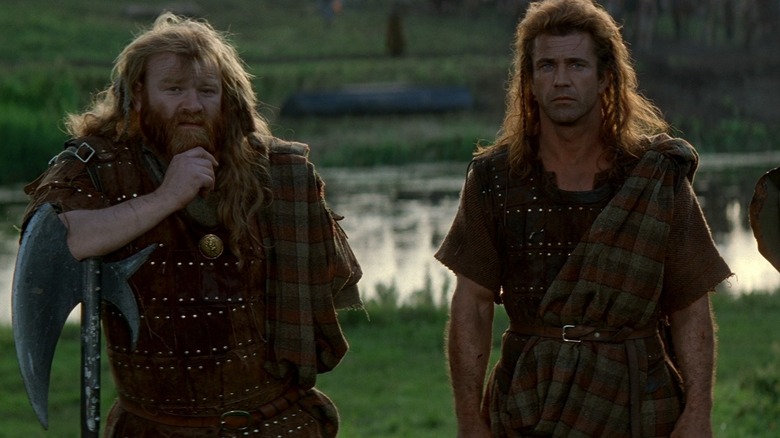Braveheart Ending Explained: History Goes Hollywood
The only surviving manuscript of Blind Harry's epic poem "The Wallace" was found bound together with a copy of John Barbour's "The Bruce," both of them having been written down by the same author (one John Ramsay) in 1488 and 1489 respectively. Scholars put the composition of "The Wallace" sometime in the 1470s, and is sometimes cited as the very first book published in Scotland. "The Wallace" (full title: "The Actes and Deidis of the Illustre and Vallyeant Campioun Schir William Wallace") was inspired, naturally, by the life of William Wallace (1270–1305), a Scottish knight who, during the First Scottish war of Independence, kicked so much English ass that he was appointed an official Guardian of the Kingdom of Scotland. He would eventually lose The Battle of Falkirk in 1298, and be executed — via hanging and then being drawn and quartered — for treason by King Edward I.
William Wallace would serve as inspiration for several major works of poetry, lit, and film over the centuries. Robert Burns wrote the lyrics to a hit song in 1793 called "Scots Wha Hae wi Wallace Bled." The 19th century was lousy with works about Wallace. Jane Porter wrote a romantic novel about Wallace in 1810 called "The Scottish Chiefs." Felicia Hemens wrote a celebrated poem about Wallace at The Battle of Falkirk called "Wallace's Invocation to Bruce" in 1819. Sir Walter Scott wrote "The Story of Sir William Wallace" in 1928. G.A. Henty wrote "In Freedom's Cause: A Story of Wallace and Bruce" in 1885. This Wallace guy was happening.
Arguably most recognizable to modern audiences is the 1995 feature film about Wallace called "Braveheart" written by Randall Wallace (no relation), and directed by and starring Mel Gibson. "Braveheart" was an enormous box office hit in 1995, and won Best Picture, Best Director, Best Cinematography, Best Makeup, and Best Sound Design at the Academy Awards. It was an old-world Hollywood historical epic of the highest order, complete with extreme violence, a touching love story, and a lot of rousing dialogue about war and freedom.
It was also about 30% historically accurate.
History via Hollywood
In case it needs clarification: Studio-approved Hollywood historical epics are perhaps one of the worst places to go to learn history. "Braveheart" is a classic example of Hollywood twisting around history in order to fit a conventional, satisfying cinematic narrative. Is it an exciting, rousing film? Yes indeed. Is it true to the actual life of William Wallace. Lord, no.
The screenplay for "Braveheart" took its framework and a lot of its story beats from the Blind Harry poem, which was, itself, exaggerated at best. There is a scene at the start of "Braveheart" that depicts the hanging of Scottish noblemen at the hands of the English at the Barns of Ayr. This is not an event that happened, but Randall Wallace included it in his screenplay, citing its dramatic power.
The story of the film — briefly — states that Scotland is under English rule and had been for some time. King Edward I (Patrick McGoohan) had taken the Scottish throne from King Alexander III, who left no heir. When Edward hung Scottish nobles to assert his rulership, a young William Wallace, then a boy, developed a lasting hatred for the occupying English. Wallace grows up abroad, learning the ways of the world. When Wallace returns to Scotland as an adult, Edward is still enacting his shenanigans by enacting the rite of jus primae noctis, allowing English noblemen to bed brides on their wedding nights before their husbands with the idea being that more English babies will be born and fewer Scots. When Wallace tries to fight off the Brits, his childhood paramour Murron (Catherine McCormack) is killed. This inspires Wallace to take up arms against the English, and gather able-bodied onto battlefields to fight the ever-ticked-off English armies.
Wallace will also eventually have a steamy affair with Princess Isabella of France (Sophie Marceau), who was hired to aid the English, but who eventually succumbs to Mel Gibson's roguish, sweaty charms. Wallace will eventually be apprehended and executed. At his execution, the English demand that he cry mercy. He instead wails "Freedoooooom!" as he dies. The final line of "Braveheart" is Wallace taking us a few years forward in time when the Scottish "fought like warrior poets" and finally "won their freedom."
The department of history sanitation
Almost none of that is accurate to history, it turns out. And it's easy to see why, when you look at the talent behind the film. Randall Wallace was born in Jackson, Tennessee and raised in Virginia. Mel Gibson spent much of his life in Australia, and most of it in the United States. As such, the narrative of a 13th century Scottish knight feels a lot more ... American. The hammering of the word "freedom" is commonly practiced in a particular form of picnic-table American patriotism, and Wallace's on-screen rallying cry of "They may take our lives, but they'll never take our freedom!" feels just as much like a motto of the U.S. Marines as it does a rousing Highland battlefield speech.
Given a general aversion to our own history in the United States (borne out by myths of history's dryness as a school topic, an aversion to date memorization in schools, and a fear that American history is inappropriate for young kids), we tend to fall back on Great Man myths, and cathartic, movie script-like turning points to wrap our heads around the grand chaos of the past. Without getting too deep into the weeds on the philosophy of history or modern educational techniques, I can say that American films about heroes and history (and "Braveheart" is an American film) tend to prefer certain types of "Save the Cat"-style screenplays and recognizable story beats when approaching history and biography. Then, in the case of anything over a century old, we jazz it up with salacious affairs, movie-ready violence, and heroic gestures.
With only a few tweaks, the "Braveheart" story of Scottish freedom could be a story of the American Revolution. Just change Edward I into George III. Oh, wait. We kind of got a Mel Gibson historical drama like that. It was called "The Patriot."
What really happened
As such, the history in "Braveheart" is sketchy at best. In the film, The Battle of Sterling Bridge didn't take place on a bridge. Entire historical figures are missing from the movie. The tartan kilts worn by Wallace and his retinue wouldn't come into being for 500 years. The film's famous blue facepaint was already a millennium out of date. And there are dozens of other inaccuracies besides.
"Braveheart" ends with Wallace narrating the events of The Battle of Bannockburn (1314) after his death. The Scottish warrior poets take to the field, defeat the British, and win their independence. The final shot of the film is a two-handed broadsword stabbed into the ground, gently waving in the Scots winds, with a well-earned peace and sense of triumph in the air. An awesome ending to a movie.
Ignore the fact that Robert the Bruce continued to battle the English until 1328, when Scotland was finally granted its independence from England. Even then, that independence was only to last for a four-year period. A second war for independence would then be fought from 1332 to 1357. So William Wallace was but one knight in a long, long series of battles and wars in the long fight for Scottish freedom, and not necessarily the one key component in it.
Wallace is still a mythic figure, of course, but there was a reason why the statue of William Wallace — one that resembles Mel Gibson and one that was clearly inspired by "Braveheart" — was returned to its sculptor after it had been repeatedly vandalized.



